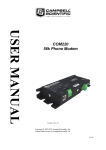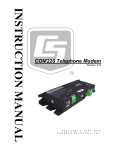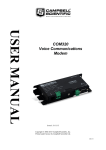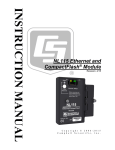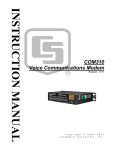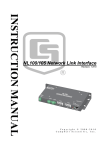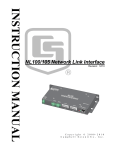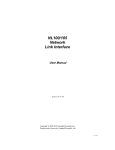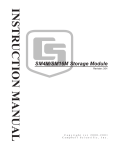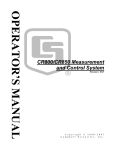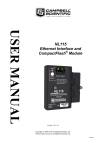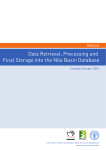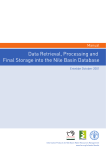Download Campbell COM220 Specifications
Transcript
COM220 Telephone Modem Revision: 8/11 C o p y r i g h t © 1 9 9 7 - 2 0 1 1 C a m p b e l l S c i e n t i f i c , I n c . Warranty and Assistance PRODUCTS MANUFACTURED BY CAMPBELL SCIENTIFIC, INC. are warranted by Campbell Scientific, Inc. (“Campbell”) to be free from defects in materials and workmanship under normal use and service for twelve (12) months from date of shipment unless otherwise specified on the corresponding Campbell invoice. Batteries, fine-wire thermocouples, desiccant, and other consumables have no warranty. Campbell's obligation under this warranty is limited to repairing or replacing (at Campbell's option) defective products, which shall be the sole and exclusive remedy under this warranty. The customer shall assume all costs of removing, reinstalling, and shipping defective products to Campbell. Campbell will return such products by surface carrier prepaid within the continental United States of America. To all other locations, Campbell will return such products best way CIP (Port of Entry) INCOTERM® 2010, prepaid. This warranty shall not apply to any Campbell products which have been subjected to modification, misuse, neglect, improper service, accidents of nature, or shipping damage. This warranty is in lieu of all other warranties, expressed or implied. The warranty for installation services performed by Campbell such as programming to customer specifications, electrical connections to products manufactured by Campbell, and product specific training, is part of Campbell’s product warranty. CAMPBELL EXPRESSLY DISCLAIMS AND EXCLUDES ANY IMPLIED WARRANTIES OF MERCHANTABILITY OR FITNESS FOR A PARTICULAR PURPOSE. Campbell is not liable for any special, indirect, incidental, and/or consequential damages. Products may not be returned without prior authorization. The following contact information is for US and International customers residing in countries served by Campbell Scientific, Inc. directly. Affiliate companies handle repairs for customers within their territories. Please visit www.campbellsci.com to determine which Campbell Scientific company serves your country. To obtain a Returned Materials Authorization (RMA), contact Campbell Scientific, Inc., phone (435) 753-2342. After an applications engineer determines the nature of the problem, an RMA number will be issued. Please write this number clearly on the outside of the shipping container. Campbell Scientific's shipping address is: CAMPBELL SCIENTIFIC, INC. RMA#_____ 815 West 1800 North Logan, Utah 84321-1784 For all returns, the customer must fill out a “Declaration of Hazardous Material and Decontamination” form and comply with the requirements specified in it. The form is available from our website at www.campbellsci.com/repair. A completed form must be either emailed to [email protected] or faxed to 435-750-9579. Campbell Scientific will not process any returns until we receive this form. If the form is not received within three days of product receipt or is incomplete, the product will be returned to the customer at the customer’s expense. Campbell Scientific reserves the right to refuse service on products that were exposed to contaminants that may cause health or safety concerns for our employees. COM220 Telephone Modem Table of Contents PDF viewers note: These page numbers refer to the printed version of this document. Use the Adobe Acrobat® bookmarks tab for links to specific sections. 1. Introduction..................................................................1 1.1 General Description ..................................................................................1 1.2 Computer Requirements ...........................................................................2 2. Specifications ..............................................................3 3. Installation....................................................................3 3.1 3.2 3.3 3.4 3.5 Connecting to Datalogger .........................................................................3 Connecting to Earth Ground.....................................................................5 Telephone to MD485 or Telephone to RF Systems..................................6 Telephone Service ....................................................................................6 Connecting to a Surge Protector ...............................................................6 4. Modem Settings ...........................................................8 5. Troubleshooting ..........................................................9 Appendices A. Changing COM220 Settings ................................... A-1 A.1 A.2 A.3 A.4 DIP Switch Settings ............................................................................ A-1 Hayes AT Commands ......................................................................... A-2 Downloading a New Operating System to the COM220.................... A-6 Program Examples.............................................................................. A-7 A.4.1 ModemCallback Example (for CR1000) .................................. A-7 A.4.2 DialModem Example (for CR1000).......................................... A-8 A.4.3 P97 Instruction (for CR10X)..................................................... A-9 A.4.4 Example Programs for Data-Callbacks via a CR1000 Datalogger Router .............................................................. A-11 B. CS I/O Connection................................................... B-1 B.1 CS I/O 9 Pin Connection......................................................................B-1 C. Theory of Operation................................................ C-1 C.1 Theory of Operation.............................................................................C-1 i COM220 Telephone Modem Table of Contents D. FCC Warning to Users of Class A Computing Devices..............................D-1 E. IC Information .......................................................... E-1 List of Figures 1. 2. 3. 4. COM220 DIP Switches.............................................................................. 1 COM220 .................................................................................................... 2 CR1000 and COM220 Using Remote Telephone Line ............................. 4 CR10X with CR10 Wiring Panel and COM220 Using RJ11C Telephone Jack ....................................................................................... 5 5. Top View of Surge Suppressor Wiring...................................................... 7 6. Side View of Surge Suppressor Wiring ..................................................... 8 A-1. COM220 to Computer Connection.................................................... A-3 A-2. Device Configuration Screen............................................................. A-4 A-3. Terminal Emulator Screen in Device Configuration ......................... A-5 A-4. Send OS Screen in Device Configuration.......................................... A-7 B-1. CS I/O Pin Out ................................................................................... B-1 List of Tables 1. Dataloggers that Require Direct 12 VDC Connection to COM220........... 4 A-1. Selecting ME Baud-rates via DIP Switches 3 and 4.......................... A-2 A-2. Maximum Datalogger ME Baud-rate ................................................ A-2 ii COM220 Telephone Modem 1. Introduction 1.1 General Description The COM220 modem is a selectable-baud-rate modem employing the Hayes AT command set. Its primary use is as a remote site phone modem connected to a CSI datalogger. The modem is powered and enabled by the batterypowered datalogger. When not active, the COM220 draws 100 to 120 μA from the datalogger’s 12 VDC output. During a call, it draws about 30 mA. The COM220 is a replacement for the COM210. However, the COM220 supports both synchronous device communication (SDC) and modem enable (ME) communication, as well as various ME baud rates (9600 to 115200). The default settings for the COM220 at shipping are SDC7, and PakBus ready (see Appendix A for details). IMPORTANT The default settings ARE NOT compatible with dataloggers that have non-PakBus operating systems (e.g., CR510, CR10X, CR23X, CR7, CR5000). However, compatibility with non-PakBus dataloggers is easily achieved by changing DIP switch settings (Figure 1). If you want to use the COM220 as a drop-in replacement for the COM210, the COM220 settings should be changed to modem enable (DIP switch 1 open), and 9600 baud (DIP switches 3 and 4 open). In addition, DIP switch 5 must be closed for connection to non-PakBus dataloggers. Instructions for configuring the COM220 are described in Appendix A. FIGURE 1. COM220 DIP Switches. Five Screws and the Outer Cover Must be Removed for Access to the DIP Switches. 1 COM220 Telephone Modem The COM220 is connected to a CSI datalogger by a 9-pin subminiature D cable. This is the same 9-pin CS I/O interface common to all Campbell Scientific dataloggers (except the CR200 series). This is not an RS-232 connection. Appendix B describes the CS I/O interface. The COM220 can be used as an originate modem at the datalogger site. For newer Pakbus dataloggers (e.g., CR800, CR1000, CR3000) use the ModemCallback instruction or the DialSequence and DialModem instructions to program the datalogger to originate a call to the computer. For non-Pakbus dataloggers (e.g., CR510, CR10X, CR23X), and for older PakBus dataloggers (e.g. CR10XPB, CR23XPB, CR510PB) use Instruction 97 to program the datalogger to originate a call to the computer. Refer to your datalogger manual and LoggerNet Help files for detailed descriptions of these instructions. In addition, Appendix A.4 includes sample programs for the ModemCallback, DialModem, and P97 instructions. The COM220 features a built-in speaker to allow monitoring of calling and connection. See Appendix A.2 for the Hayes AT commands that affect the speaker on/off and volume settings. FIGURE 2. COM220 1.2 Computer Requirements A Hayes-compatible modem is used at the computer site with Campbell Scientific computer software to call the datalogger attached to the COM220. The computer’s modem must be configured to the proper settings using a set of modem initialization strings in the software program’s pick list. 2 COM220 Telephone Modem 2. Specifications • Standards: V.92, K56Flex, V.90, V.34, V.32bis, V32, V23, V22bis, V22, V.21, B212, B103 • Registration: FCC US: 3A4M508BSM2-T-W IC 2377 A-SM2TW TBR21 • Operating voltage: 12 VDC • Current drain: 100 to 120 μA quiescent; 30 mA active • Communication rate between datalogger and COM220: 9600, 38400, 57600, 115200 bps (selected by user) • Operation: Full-duplex over standard analog phone lines • Operating temperature: -25° to +50°C std, -40° to +85°C optional • Dimensions: 6.5” x 1.0” x 2.6” (16.5 x 2.5 x 6.6 cm) • Weight: 0.35 lbs (0.16 kg) 3. Installation The COM220 is designed to be used with standard analog telephone lines. It will not work with a digital telephone line. Connection to telephone-companyprovided coin service (central office implemented systems) is prohibited. Connection to party line service is subject to state tariffs. 3.1 Connecting to Datalogger Connect the cable from the telephone RJ11C jack to the modem as shown in Figure 4. If the telephone company has not installed surge protection in the telephone line (no RJ11C jack), one must install surge protection (CSI item number 6362 or 4330) and connect the ring and tip terminal blocks as shown in Figure 3. Current Campbell Scientific dataloggers provide 12 VDC to the COM220 from the CS I/O port via the SC12 cable (Figure 2). Older dataloggers do not provide 12 VDC on their CS I/O port. When used with the older dataloggers listed in Table1, 12 VDC and ground need to be connected via the green power connector on the side of the COM220 (see Figure 4). 3 COM220 Telephone Modem TABLE 1. Dataloggers that Require Direct 12 VDC Connection to COM220 CR10(X) with silver wiring panel CR10(X) with black CR10 wiring panel (P/N 8032) 21X(L)—serial number 13,442 or lower CR500⎯serial number 1764 or lower CR7—700X serial number 2778 or lower 2 3 L H 2 4 5 L H 3 6 7 L H POWER IN G 12V 8 4 L P2 1 EX1 1 H P1 SE DIFF CAUTION DC ONLY G 12V GROUND LUG 11 12 6 H L 10 5 H L 13 14 7 H L 15 16 8 H L CR1000 WIRING PANEL EX3 9 EX2 SE DIFF CS I/O PERIPHERAL PORT G C8 C7 C5 G C6 C4 COM3 COM4 Tx Rx Tx Rx C3 COM1 COM2 Tx Rx Tx Rx C2 G 12V SW-12 G 12V G G 5V POWER OUT C1 RS-232 (Not Isolated) SN: MADE IN USA SDM SC12 Cable Blue = Ring Burial Phone Cable Earth Ground Blue/White = Tip Phone Line Transient Protector (Model 6362 or 2372-01) FIGURE 3. CR1000 and COM220 Using Remote Telephone Line 4 COM220 Telephone Modem DIFF SE AG H L AG H L AG H L AG E3 AG G G 4 5 6 7 8 9 10 11 12 CAMPBELL SCIENTIFIC INC. SE DIFF G G G G 12V 12V SWITCHED 12V SERIAL I/O G 12V POWER IN CR10 MADE IN USA WIRING PANEL NO. SWITCHED 12V 1 2 3 4 5 6 CONTROL EARTH 1 2 3 AG H L AG H L AG H L AG E1 E2 G G G 5V 5V P1 P2 C8 C7 C6 C5 C4 C3 C2 C1 To Earth Ground Red (+12v) Black (Ground) 14 AWG Ground Wire SC12 Cable Telephone Wall Jack FIGURE 4. CR10X with CR10 Wiring Panel and COM220 Using RJ11C Telephone Jack 3.2 Connecting to Earth Ground Connect the green 14 awg grounding wire (provided with the COM220) to the ground terminal (GND) on the COM220 and to the enclosure’s earth ground connection. If the site does not have a grounded enclosure, then connect the ground wire directly to an earth ground connection. The datalogger ground should also be tied to the earth ground (see Figures 3 and 4). CAUTION The modem must be grounded for its transient protection to work. 5 COM220 Telephone Modem 3.3 Telephone to MD485 or Telephone to RF Systems Telephone to MD485 or telephone to radio configurations can be utilized for communicating with multiple dataloggers through one telephone line. For telephone to MD485 or telephone to radio communications (with no datalogger router), the COM220 should be set for ME mode. The COM220 and MD485 should be set to the same baud rate. When using a PakBus network with a datalogger configured as a router, the COM220 can be set for SDC7 and the radio for SDC8, or vice versa. Contact a Campbell Scientific Applications Engineer for more information. In addition, Appendix A.4.4 includes example programs for both a router datalogger and a remoter datalogger communicating by telephone to MD485 or telephone to radio. 3.4 Telephone Service The goal of the telephone company is to provide you with the best service it can. In order to do this, it may occasionally be necessary for them to make changes in their equipment, operations, or procedures. If you have any questions about your telephone line, such as how many pieces of equipment you can connect to it, the telephone company will provide this information upon request. If the telephone company requests information concerning the equipment which you have connected to your telephone line, the FCC registration number and the ringer equivalence number (REN) of the COM220 are listed on its label. Additional technical information from the FCC and IC on the COM220 is available in Appendices D and E, respectively. NOTE If the local telephone company does not provide phone-line surge protection, a Campbell Scientific surge suppressor should be used. Refer to Section 3.5 for more information. 3.5 Connecting to a Surge Protector Campbell Scientific offers two surge protectors (CSI model 4330 and CSI model 6362). The 4330 and 6362 are essentially the same, except the 6362 has hardware for mounting to an enclosure backplate. NOTE The 4330 is also known as the 2374-01. The 4330 and 6362 have a protector element for each line that consists of a heavy-duty-rated, two-element gas tube, an external backup gap assembly, and a switch-grade shorting mechanism. The gas tubes (tip and ring) are sealed in a fire-resistant plastic body. DC Breakdown @ 100 V/sec is 300 to 500 volts; DC extinguishing @ 52 V, 135 V, and 150 V is less than 150 milliseconds. Figures 5 and 6 show the wiring for connecting the surge suppressor. Color coding of wires may vary. The important consideration is to follow TIP all the way through and RING all the way through. Getting wires crossed typically does not damage anything. The phone line just will not work until the wires are straightened out. 6 COM220 Telephone Modem CAUTION Phone wires are live, typically with low voltage (24 Vdc). While not harmful in most situations, Campbell Scientific recommends installing the surge protector in dry weather only by technicians with a healthy heart. FIGURE 5. Top View of Surge Suppressor Wiring 7 COM220 Telephone Modem FIGURE 6. Side View of Surge Suppressor Wiring 4. Modem Settings The COM220 is shipped from the factory with default settings that support PakBus dataloggers (e.g., CR800, CR1000, CR3000, CR10XPB). The modem comes configured for Synchronous Device Communication (SDC7), and if using a PakBus datalogger, can answer a call as soon as a call is detected. Default settings must be changed if using a non-PakBus datalogger. IMPORTANT The default settings ARE NOT compatible with dataloggers that have non-PakBus operating systems (e.g., CR510, CR10X, CR23X, CR7, CR5000). However, compatibility with non-PakBus dataloggers is easily achieved by changing DIP switch settings (Figure 1). If you want to use the COM220 as a drop-in replacement for the COM210, the COM220 settings should be changed to modem enable (DIP switch 1 open), and 9600 baud (DIP switches 3 and 4 open). In addition, DIP switch 5 must be closed for connection to non-PakBus dataloggers. Instructions for configuring the COM220 are described in Appendix A. You can modify the following COM220 settings with DIP switches: 1) Communication mode (e.g., SDC or Modem Enable) 2) ME baud rate 3) PakBus ready Additional changes (see examples below) may be modified with Hayes AT commands. Appendix A.2 describes the procedures and commands required to effect the changes described in this section. 8 COM220 Telephone Modem Some of the AT command settings one may change are: Disable auto-answer: This option is used only when the modem is not to answer a call. For example, the COM220 is connected to a telephone line that is to be used part time for voice communication. In this situation it is best to have the datalogger call the computer. Speaker On/Off and Volume: Default settings have the speaker on only during call establishment and set to a low volume. The speaker may be turned completely off in order to limit the current drain during the connection or so you don’t hear the speaker. It is also possible to set the speaker volume higher, if you want to hear the speaker better than the default low volume setting. Answer on Xth ring: This option is used when the modem is sharing a line and you only want it to answer after a specified number of rings. For example, the COM220 is sharing a line with people at an office. It can be programmed to only answer after the third ring. If the PC calls when the office is closed and no one answers the phone after three rings, the datalogger will pick it up. Change telephone system types: Change from the Bell 212A (U.S. and Canada) system to a CCITT V.32 (foreign, 9600 baud) or CCITT V.22 (foreign, 1200 baud) system. This does not mean that the COM220 is tested and approved for all foreign countries. CITT is an international consultative committee that sets international communications usage standards. V.32 and V.22 are CCITT standards that the COM220 meets. 5. Troubleshooting When the Campbell Scientific software cannot establish a link to a remote datalogger that is connected to a COM220, check the following: 1) Verify that the modem initialization settings on your computer are correct for your specific calling modem (i.e., the modem attached to your computer). See the calling modem’s software manual and/or help screens for more information. 2) If using a non-PakBus datalogger (e.g., CR510, CR10X, CR23X, CR7, CR5000 with array-based operating system), verify that DIP switch 5 on the COM220 is in the CLOSED position. For PakBus dataloggers (e.g., CR800, CR850, CR1000, CR3000, CR10XPB, CR23XPB, CR510PB), DIP switch 5 should be open. See Appendix A.1 for details. 3) If using a non-PakBus datalogger (e.g., CR510, CR10X, CR23X, CR7, CR5000), verify that DIP switch 1 on the COM220 is in the OPEN (modem enable) position. For PakBus loggers (e.g., CR800, CR850, CR1000, CR3000, CR10XPB, 23XPB, etc.), DIP switch 1 can be in either position, but closed (SDC7) is preferred. See Appendix A.1 for details. 9 COM220 Telephone Modem 4) If the COM220 is set for Modem Enable (DIP switch 1 open), verify that the ME baud rate selected (switches 3, 4) agrees with related communication instructions in the datalogger program. Instructions for setting the COM220’s ME baud rate are found in Appendix A.1. 5) If the COM220 is set for Modem Enable (DIP switch 1 open) and you are unable to connect to the datalogger, try setting the datalogger BaudrateME to a negative number (e.g. -9600) in order to enable auto-bauding in the datalogger. If the datalogger BaudrateME is positive (due to an earlier program instruction or Status Table configuration) the datalogger will be unable to communicate with the COM220 unless baud rates happen to match. A good rule of thumb is to keep baud rates negative (-) in programs and when configuring the Status Table to allow datalogger auto-bauding. 6) If unable to connect to a datalogger via the COM220, make sure that the datalogger is not beaconing to the same port for which the COM220 is configured (e.g., if the COM220 is configured for SDC7 and the datalogger's BeaconSDC7 is set to something other than 0, then a connection cannot be established). 7) If the COM220 is in Modem Enable mode, verify that the COM220 is the only Modem Enable device connected to the datalogger. Other common Campbell Scientific modem enable devices are the SC32B, some RF modems, the MD485, the RF401, the SC932A, and the PDA-to-CS I/O connector. 8) If the COM220 is in SDC mode (the default is SDC7, with DIP switch 1 closed and DIP switch 2 open), verify that any other SDC devices attached to the datalogger are using a different SDC address (e.g., if the COM220 is configured for SDC7, another SDC device attached to the datalogger must use SDC8). 9) Verify that no other software application is currently using the same COM port on the computer. Even if a program is minimized in windows, it may put a lock on a COM port. Some notebook computers do not automatically activate the COM ports. Verify that the COM port you are using is activated. 10) Use the Low Level Log in the Campbell Scientific software, LoggerNet, [under Status Monitor, Tools, Log Tool, Options, View Low Level Log (I/O)] to see connection progress as a link is being established. Assuming the above items are O.K., the Low Level Log will display “ATDT#######”. Where #### is the phone number entered in LoggerNet Setup’s Phone Remote for the datalogger you are trying to call. The modem attached to the computer will respond back to the computer with result codes showing how the call is progressing. These responses should include “RING” and “CONNECT ####” where #### is the negotiated modem-to-modem connection baud rate. The maximum baud rate setting in Setup’s PakBusPort [LoggerNet, Setup, PakBusPort (in the device map)] may limit the baud rate selected by the modems since it defaults to 9600. You can sometimes achieve a higher connection baud rate by raising the PaKBus Port’s maximum baud rate. 10 COM220 Telephone Modem 11) Can you attach a normal analog telephone to the line and make a call out? If not, contact your local telephone company. If you can make a call out but the connection is poor or faint, contact your local telephone company. 12) Verify the COM220 is receiving 12 VDC. If the COM220 is receiving 12 VDC from a separate power supply instead of the datalogger, is the ground of the separate power supply connected to the datalogger’s ground? 13) Verify the datalogger is turned on. To comply with FCC rules and regulations, all repairs on the COM220 modem must be performed by Campbell Scientific, Inc. or an authorized agent of Campbell Scientific, Inc. For assistance in installation, troubleshooting, or for repair, contact Campbell Scientific: Campbell Scientific, Inc. 815 West 1800 North Logan, Utah 84321-1784 Telephone: (435) 753-2342 Fax: (435) 750-9540 Web site: www.campbellsci.com 11 COM220 Telephone Modem 12 Appendix A. Changing COM220 Settings CAUTION Changing any of the modem's settings may result in communication problems. After changing the settings, try the modem locally before installing it at a remote location. To speed problem resolution when contacting Campbell Scientific for support, please inform us of any modem setting changes that have been made. A.1 DIP Switch Settings The following COM220 settings are changed by opening or closing DIP switches: 1) Communication mode, either Synchronous Device Communication (SDC) or Modem Enable (ME) 2) ME baud-rate 3) PakBus ready. To change DIP switch settings, the outer cover must first be removed by unscrewing and removing the five Philips head screws on the cover. IMPORTANT It is necessary to cycle power to the COM220 for changes to the DIP switch settings to take effect. This is done by removing the 9 pin connector for about 5 seconds. As with other devices, if you leave the power off for too short a time, you may get unexpected results. DIP Switches 1 and 2: SDC or Modem Enable The COM220 supports Synchronous Device Communication (SDC) and Modem Enable (ME) communication. Switch 1 selects between SDC and ME. If switch 1 is open, ME mode is selected. If switch 1 is closed and switch 2 is open (default), SDC7 is selected. If both switch 1 and 2 are closed, SDC8 is selected. SDC is not supported by non-Pakbus operating systems (e.g., CR10X, CR23X, CR7, CR510). Hence, to connect with these older dataloggers, switch 1 must be open (i.e., Modem Enable mode selected). DIP Switches 3 and 4: ME Baud-rates DIP switches 3 and 4 only have effect when the COM220 is in Modem Enable mode. If the COM220 is in ME mode, switches 3 and 4 select the baud-rate setting between the COM220 and the datalogger as follows: A-1 Appendix A. Changing COM220 Settings TABLE A-1. Selecting ME Baud-rates via DIP Switches 3 and 4 ME Baud-rate 9600 38400 57600 115200 Switch 3 Open Open Closed Closed Switch 4 Open Closed Open Closed Please note that older dataloggers (e.g. CR10X, CR23X, CR510) cannot support the highest COM220 ME baud-rates. Table A-2 lists maximum datalogger baud-rates. TABLE A-2. Maximum Datalogger ME Baud-rates Datalogger CR10X, CR510, CR7, CR21X CR23X CR5000 CR800, CR1000, CR3000 Max Baud-rate 9600 38400 57600 115200 DIP Switch 5: PakBus Ready Switch 5 should be open (default) for PakBus dataloggers (e.g., CR800, CR1000, CR3000, CR10XPB, CR23XPB, CR510PB), but must be closed for non-Pakbus dataloggers (e.g., CR10X, CR23X, CR510, CR5000). This switch determines if the clock/handshake line is used to detect the ME-PAUSE state. DIP Switches 6 and 7: Not used DIP Switch 8: Configuration Mode Closing DIP switch 8 (and cycling power to the COM220) places the COM220 in configuration mode. The COM220 can be configured using an SC532 or an SC532A with a 12V AC adapter (part number 15966) and Device Configuration utility ver 1.6 or newer and Hayes AT Commands (see below). A.2 Hayes AT Commands In order to configure the COM220 with Hayes AT commands, you will need the Campbell Scientific Device Configuration utility ver 1.6 or newer and a SC532 or SC532A device. An SC12 cable must be connected to the peripheral port on the SC532 or SC532A and the CS I/O port on the COM220. Another cable should connect the “RS232” port (if using an SC532 device) or the “PC” port (if using an SC532A device) to one of your computer's serial ports. If using an SC532A device, power will be provided to the modem by the SC532A with a 12V AC adapter (Figure A-1). However, if using the older SC532, you must apply 12 V to the COM220 via the green connector. A-2 Appendix A. Changing COM220 Settings FIGURE A-1. COM220 to Computer Connection To configure the COM220 with Hayes AT commands, follow these steps: 1) Close DIP Switch 8 on the COM220 (power to the COM220 must be cycled for ~ 5 sec before changes to DIP switch settings are effective). 2) You must use an SC532A with a 12V AC adapter or an SC532 interface to communicate with the modem. Connect the “PC” port (called “RS232” on the SC532) to a serial port on your computer via an RS232 cable. Leave the COM220 modem disconnected for now. 3) Run Device Configuration ver 1.6 utility or newer. 4) Select Com220 from the Device Configuration utility menu (Figure A-2). 5) Make sure the appropriate serial port is selected on the left panel of the Device Configuration utility window and click on the connect button. 6) Once you have clicked on the connect button, connect the peripheral port on the SC532(A) or SC532 to the CS I/O port on the modem with a SC12 cable. If using a SC532, you will also have to apply 12V to the COM220 via a green connector attached to a power supply. If using an SC532A device, power will be provided to the modem by the SC532A (NOTE: you must click on the connect button BEFORE applying power to the COM220). A-3 Appendix A. Changing COM220 Settings 7) Follow the instructions that appear in the terminal emulator screen (Figure A-3). 8) Be sure to save all new commands before exiting (by entering 5 and enter). 9) When finished, return DIP switch 8 on the COM220 to its open position. FIGURE A-2. Device Configuration Screen A-4 Appendix A. Changing COM220 Settings FIGURE A-3. Terminal Emulator Screen in Device Configuration HAYES AT COMMAND SUMMARY: This manual does not attempt to be a primer on the Hayes AT command set. The commands are, therefore, only summarized below. For most applications, these commands will not need to be used. Except as noted, all commands should begin with an “AT” and end with a carriage return (hit the [Enter] key). There are no “O” as in Oscar commands, only “0” as in Zero commands. For example, to change the default number of rings from 1 to 3, the command is: ATS0=2 (the default is 1 ring as the MPU sends ATS0=1 by default to the modem module). To turn the speaker off, the command is: ATM0 Note, for command changes to be effective, you MUST hit enter after typing the command and you MUST hit 5 to save the new command before disconnecting or exiting set up. COMMANDS TO CHANGE DEFAULT MODES: B1 (default) B0 L0 L1 (default) L2 L3 CCITT V.32 (9600 baud), Bell 212A (1200 baud), and Bell 103 (300 baud) CCITT V.32 (9600 baud), CCITT V.22 (1200 baud), and CCITT V.21 (300 baud) Lowest speaker volume Low speaker volume Medium speaker volume High speaker volume A-5 Appendix A. Changing COM220 Settings CAUTION M0 M1 (default) M2 Speaker always off Speaker on during call establishment Speak on during entire call session S0=0 S0=1 (default) S0=2 S0=n Disable Auto Answer Answer on second ring Answer on third ring Answer on (n + 1) ring. When doing datalogger to datalogger communications with the COM220, if more than six rings are specified, the datalogger may time out before the modem answers; communication will never be established! Be sure to try the set up locally before installing at a remote location. A.3 Downloading a New Operating System to the COM220 To download a new operating system to the COM220, follow these steps: 1) You must use an SC532A or an SC532 interface to communicate with the modem. Connect the PC port (called “RS232” on the SC532) to a serial port on your computer via an RS232 cable. Leave the modem disconnected for now. 2) Make sure that you have the appropriate serial port selected in the left panel of the Device Configuration Utility window. 3) Click on the Start button. 4) In the resulting file open dialogue box that appears, select the file that should be sent as the modem's operating system. Do not attempt to load any operating system other than that designed for the COM220 modem. 5) Once you have pressed OK in the file open dialogue box, connect the peripheral port on the SC532(A) or SC532 to the CS I/O port on the modem with an SC12 cable. If using an SC532, you will also have to apply 12 V to the COM220 via a green connector attached to a power supply. If using an SC532A device, power will be provided to the modem by the 12 V adapter connected to the SC532A (NOTE: you must highlight/select the operating system file to be sent BEFORE applying power to the COM220). 6) The program should now send the operating system to the modem. Interrupting this process may corrupt the modem operating system. A-6 Appendix A. Changing COM220 Settings FIGURE A-4. Send OS Screen in Device Configuration A.4 Program Examples A.4.1 ModemCallback Example (for CR1000) The ModemCallBack instruction is available in the CR1000 with operating system std.12 or greater, in the CR3000 with operating system std.05 or greater and CR800 or CR850 with operating system std.03 or greater. The following program uses the ModemCallBack instruction to call LoggerNet every 2 minutes. The ModemCallBack instruction assumes that LoggerNet resides at the phone number and that callback is enabled in LoggerNet Setup, both for the comport and for the datalogger. Public PTemp, batt_volt, Count, Result as Long Const Abort = 0 ' False DataTable (Test5,1,-1) DataInterval (0,0,Sec,10) Sample (1,batt_volt,FP2) Minimum (1,batt_volt,FP2,0,False) Maximum (1,batt_volt,FP2,False,False) Sample (1,PTemp,FP2) Minimum (1,PTemp,FP2,0,False) Maximum (1,PTemp,FP2,False,False) Sample (1,Count,FP2) EndTable BeginProg Scan (2,Min,3,0) Count = Count + 1 PanelTemp (PTemp,250) Battery (Batt_volt) A-7 Appendix A. Changing COM220 Settings ModemCallBack(Result,ComSDC7,9600,0,"5551212","",40,60,Abort) CallTable Test5 NextScan End Program A.4.2 DialModem Example (for CR1000) The program below does 2-minute callbacks via the COM220 configured for SDC7. DialModem is set equal to a variable, so that the success/failure result can be used by the EndDialSequence instruction. If the call fails, the link will be terminated at the EndDialSequence instruction. If the call is successful, the device will be kept on-line until the SendVariables command is completed. Note, that for data callbacks to occur, callback enable must be selected in LoggerNet Setup both for the comport and for the datalogger. 'Replace DialModem phone number with your PC's phone number Public batt_volt, Result Public PTemp, TCvalue_F, dummy Public RespStrng, DialSuccess, AccumDialFails as LONG DataTable (DC1,1,1000) DataInterval (0,0,Sec,10) Sample (1,PTemp,FP2) Sample (1,TCvalue_F,FP2) Sample (1,DialSuccess,FP2) EndTable DialSequence (4094) 'Establishes a phone connection if there isn't one already. DialSuccess =DialModem (ComSDC7,-115200,"5551212","") ' " Param 2 baudrate setting affects sdc bit rate." Param 4 allows OS to accept any listed modem response. If DialSuccess = 0 then AccumDialFails = AccumDialFails + 1 EndDialSequence (DialSuccess) ‘ -1 = success, 0 = failure of response to match Param 4 BeginProg Scan (2,Min,3,0) PanelTemp (PTemp,250) Battery (Batt_volt) dummy = 0 TCDiff (TCvalue_F,1,mV2_5C,1,TypeT,PTemp,True ,0,250,1.8,32) SendVariables (Result,ComSDC7,4094,4094,0000,3500,"Public","Callback",dummy,1) 'Establishes static route to LN '35 sec timeout allows time to dial/train CallTable DC1 NextScan EndProg A-8 Appendix A. Changing COM220 Settings CAUTION The COM220 can return several possible responses once connected (each terminating in a carriage return): “1” CONNECT “5” CONNECT1200 “10” CONNECT2400 “13” CONNECT9600 “18” CONNECT4800 “20” CONNECT7200 “21” CONNECT12000 “25” CONNECT14400 Hence, to work with the COM220, the user must put in a NULL string, else the DialModem will fail unless by chance it returns the specific string the user entered. Therefore, it is highly recommended to use the “” string for the connect string, unless the user is using some other modem that he knows has a different response string than those listed above. A.4.3 P97 Instruction (for CR10X) Instruction 97 is a Program Control Instruction that makes the following types of calls: • Datalogger calls a computer to send data. • Datalogger calls a voice phone using our voice-synthesized modem. • Datalogger calls a remote datalogger to retrieve its input locations. Instruction 97 has the following parameters: • Parameter 1 - Modem/Baud-rate Codes • Parameter 2 - Flag No. to Disable P97 • Parameter 3 - Call Time Limit (seconds) • Parameter 4 - Seconds Before Fast Attempts • Parameter 5 - Fast Attempts • Parameter 6 - Minutes Before Slow Attempts • Parameter 7 - Failure Location • Parameter 8 - Callback ID A-9 Appendix A. Changing COM220 Settings IMPORTANT Do not put Instruction 97 inside a loop or conditional statement; it must be executed each time the table is run. In the example below, the program does two minute data callbacks via the COM220 phone modem. Edit instruction 13 with your PC’s (LoggerNet’s) phone number. Remember to set COM220 DIP switch 5 to “closed”, switch 1 open for Modem Enable mode, and switches 3 and 4 open for 9600 baud. The callback ID in this example is 222. The callback ID is a user-specified number and must also be entered in LoggerNet Setup for callbacks to work. *Table 1 Program 01: 5 Execution Interval (seconds) ; Prevent callback when program Compiled 1: If Flag/Port (P91) 1: 28 Do if Flag 8 is Low 2: 30 Then Do 2: Do (P86) 1: 15 Set Flag 5 High 3: Do (P86) 1: 18 Set Flag 8 High 4: End (P95) 5: Batt Voltage (P10) 1: 1 Loc [ BatVolt ] ;measure battery voltage 6: Internal Temperature (P17) 1: 2 Loc [ TEMP_PANL ] ;measure panel temperature 7: If time is (P92) 1: 0 -- Minutes (Seconds --) into a 2: 10 Interval (same units as above) 3: 10 Set Output Flag High (Flag 0) ;final storage every 10 seconds 8: Real Time (P77) 1: 111 Day,Hour/Minute,Seconds (midnight = 0000) ;place a time stamp 9: Sample (P70) 1: 1 2: 1 Reps Loc [ BatVolt ] ;sample battery voltage 10: Sample (P70) 1: 1 2: 2 Reps Loc [ Temp_PANL] ;sample panel temperature 11: If time is (P92) 1: 0 Minutes (Seconds --) into a 2: 2 Interval (same units as above) 3: 25 Set Flag 5 Low A-10 Appendix A. Changing COM220 Settings 12: Initiate Telecommunications (P97) 1: 22 Phone Modem/9600 Baud ;set baud-rate/modem 2: 5 Disabled when User Flag 5 is High 3: 45 Seconds Call Time Limit 4: 0 Seconds Before Fast Retry 5: 0 Fast Retries 6: 0 Minutes Before Slow Retry 7: 3 Failures Loc [ Failures ] 8: 222 Callback ID ;must also enter callback ID in LoggerNet Setup 13: Extended Parameters (P63) ;7-digit phone number 1: 5 Option 2: 5 Option 3: 5 Option 4: 1 Option 5: 2 Option 6: 1 Option 7: 2 Option 8: 13 Option ;13 is the termination character; always place after phone number End Program A.4.4 Example Programs for Data-Callbacks via a CR1000 Datalogger Router. In order to do data callbacks via a datalogger router with COM220 and RF401s or MD485s, they must all be configured to communicate with one another. In addition, two programs are necessary: one for the datalogger router and one for the remote datalogger. Below are example programs for a datalogger router and a remote datalogger. For these examples, the COM220 is configured for SDC7 and the router datalogger has the following settings (you can enter these settings via the datalogger keypad or from the LoggerNet status table): PakBusAddress = 2, IsRouter = 1 or True, and BeaconSDC8=30, enabling the router to discover the remote. The remote datalogger’s PakBusAddress = 1. In addition, the RF401s or MD485s are set for CSDC8 (see the RF401 or MD485 manual for directions on configuring these devices). Program for CR1000 Router: 'Router program for data callback via router w/ phone link to LoggerNet 'Phone to MD485 or RF401 w/DL at Base 'Router PakBus Address = 2, IsRouter = 1, BeaconSDC8 = 30 to discover Remote DL which has PBA = 1 'Router COM220= SDC7; Base RF401 CSDC8; Remote RF401 CSDC8. 'LoggerNet PakBusPort has PBA = 4094 ‘ PC-pcMODEM --------COM220sdc7-CR1000(2)-RF401sdc8~~~~~~~~~~~RF401sdc8-CR1000(1) Public PanelTemperature, BatteryVoltage, DialSuccess Public Flag(10) AS BOOLEAN A-11 Appendix A. Changing COM220 Settings SequentialMode DataTable (TestA,1,-1) DataInterval (0,2,Sec,10) Minimum (1,BatteryVoltage,FP2,0,False) Sample (1,PanelTemperature,FP2) EndTable DialSequence (4094) StaticRoute(ComSDC8,4094,4094) ' So router discovers LoggerNet server DialSuccess = DialModem (ComSDC8,9600,"5551212","") ‘ Param 4 = "" allows CR1000 to accept all possible COM220 responses ‘ DialSuccess: -1 means successful, 0 means failure. EndDialSequence (DialSuccess) BeginProg Scan (2,Sec,0,0) PanelTemp (PanelTemperature,250) Battery (BatteryVoltage) CallTable TestA NextScan EndProg Remote datalogger program for CR1000: 'Remote program for 2 minute data callbacks via DL router with RF401 or MD485 link and COM220 link 'Datalogger router PakBusAdddress = 2 'LoggerNet server PakBusAddress = 4094 'Replace DialModem phone number with your PC's phone number Public batt_volt, Result Public PTemp, TCvalue_F, dummy Public RespStrng, DialSuccess DataTable (DC1,1,1000) DataInterval (0,0,Sec,10) Sample (1,PTemp,FP2) Sample (1,TCvalue_F,FP2) Sample (1,DialSuccess,FP2) EndTable BeginProg Scan (2,Min,3,0) PanelTemp (PTemp,250) Battery (Batt_volt) dummy = 0 TCDiff (TCvalue_F,1,mV2_5C,1,TypeT,PTemp,True ,0,250,1.8,32) SendVariables(Result,ComSDC7,2,4094,0000,3500,"Public","Callback",dummy,1) '35 sec timeout allows time for phone modems to dial/train CallTable DC1 NextScan EndProg A-12 Appendix B. CS I/O Connection B.1 CS I/O 9-Pin Connection The pin out of the connector is shown in Figure B-1. The direction of the signal relative to the modem is shown in parenthesis. Unless specified otherwise, all levels are 0 V for logic low, 5 V for logic high. FIGURE B-1. CS I/O Pin Out 1. (input) +5 VDC supply. Used to power internal line drivers for ‘Ring’ and ‘RX Data’ output signals. 2. (input) Ground 3. (output) Ring - a logic high signifies a ring signal has been detected 4. (output) RX Data - serial data from COM220 5. (input) Modem Enable - a logic high internally switches power to the modem. A logic low internally shuts off power to the modem. 6. (input) Serial Device Enable - a logic high disables communication with the modem without removing power or changing the modem's mode. 7. (input) SDC clock. . 8. (input) +12 VDC supply 9. (input) TX Data - serial data to COM220 B-1 This is a blank page. Appendix C. Theory of Operation C.1 Theory of Operation The COM220 modem is used to transmit data over bandwidth-limited channels such as telephone lines by modulating audio tones. The COM220 uses various modulation schemes including FSK (Frequency Shift Keying), TCM (Trellis Coded Modulation), QAM (Quadrature Amplitude Modulation), and DPSK (Differential Phase Shift Keying). The telephone company gives a 40 to 150 VRMS, 20 Hz signal on the telephone lines to signify a ring, which is typically on for two seconds and off for four seconds. The COM220 is supplied with 12 V from the datalogger’s CS I/O connector or from the COM220’s external power connector. The 12 V is then regulated to +5 V to give power to the ring detect circuitry. The ring detection circuitry is continuously powered but draws less than 2 μA. The ring signal is passed on to the datalogger through an opto-coupler. The datalogger responds to a “ring” by raising the Modem Enable line, which internally switches the regulated +5 V supply to the rest of the modem’s circuitry. The modem then answers and remains off-hook until it loses the carrier or the datalogger lowers the Modem Enable line. The datalogger lowers the Modem Enable line by remote command or after 40 seconds in the absence of a command. When the Modem Enable line goes low, the COM220 internally removes the +5 V from the modem circuitry, dropping power to the off-hook relay and thus placing the telephone line on-hook. The COM220’s ring detect circuitry is still powered at this time. To reject noise common to both telephone lines and to satisfy registration requirements, the modem circuitry is electrically isolated from the telephone lines by using an opto-isolator and a coupling transformer. C-1 This is a blank page. Appendix D. FCC Warning to Users of Class B Computing Devices WARNING This equipment generates, uses, and can radiate radio frequency energy, and if not installed and used in accordance with the instruction manual, may cause interference to radio communications. It has been tested and found to comply with the limits for a Class B computing device pursuant to Subpart J of Part 15 of FCC Rules, which are designed to provide reasonable protection against such interference when operated in a COMMERCIAL ENVIRONMENT. Operation of this equipment in a residential area may cause interference to radio and television reception. The operator must take whatever measures are necessary to correct the interference. D-1 This is a blank page. Appendix E. IC Information NOTE Industry Canada (IC) was formerly known as DOC. CP-01, Issue 8, Part I Section 14.1 “NOTICE: The Industry Canada label identifies certified equipment. This certification means that the equipment meets certain telecommunications network protective, operational and safety requirements as prescribed in the appropriate Terminal Equipment Technical Requirements document(s). The Department does not guarantee the equipment will operate to the user’s satisfaction. “Before installing this equipment, users should ensure that it is permissible to be connected to the facilities of the local telecommunications company. The equipment must also be installed using an acceptable method of connection. The customer should be aware that compliance with the above conditions may not prevent degradation of service in some situations. “Repairs to certified equipment should be coordinated by a representative designated by the supplier. Any repairs or alterations made by the user to this equipment, or equipment malfunctions, may give the telecommunications company cause to request the user to disconnect the equipment. “Users should ensure for their own protection that the electrical ground connections of the power utility, telephone lines and internal metallic water pipe system, if present, are connected together. This precaution may be particularly important in rural areas. CAUTION Users should not attempt to make such connections themselves, but should contact the appropriate electric inspection authority, or electrician, as appropriate.” CP-01, Issue 8, Part I Section 14.2 “NOTICE: The Ringer Equivalence Number (REN) assigned to each terminal device provides an indication of the maximum number of terminals allowed to be connected to a telephone interface. The termination on an interface may consist of any combination of devices subject only to the requirement that the sum of the Ringer Equivalence Numbers of all the devices does not exceed 5.” E-1 This is a blank page. Campbell Scientific Companies Campbell Scientific, Inc. (CSI) 815 West 1800 North Logan, Utah 84321 UNITED STATES www.campbellsci.com • [email protected] Campbell Scientific Africa Pty. Ltd. (CSAf) PO Box 2450 Somerset West 7129 SOUTH AFRICA www.csafrica.co.za • [email protected] Campbell Scientific Australia Pty. Ltd. (CSA) PO Box 444 Thuringowa Central QLD 4812 AUSTRALIA www.campbellsci.com.au • [email protected] Campbell Scientific do Brazil Ltda. (CSB) Rua Luisa Crapsi Orsi, 15 Butantã CEP: 005543-000 São Paulo SP BRAZIL www.campbellsci.com.br • [email protected] Campbell Scientific Canada Corp. (CSC) 11564 - 149th Street NW Edmonton, Alberta T5M 1W7 CANADA www.campbellsci.ca • [email protected] Campbell Scientific Centro Caribe S.A. (CSCC) 300 N Cementerio, Edificio Breller Santo Domingo, Heredia 40305 COSTA RICA www.campbellsci.cc • [email protected] Campbell Scientific Ltd. (CSL) Campbell Park 80 Hathern Road Shepshed, Loughborough LE12 9GX UNITED KINGDOM www.campbellsci.co.uk • [email protected] Campbell Scientific Ltd. (France) 3 Avenue de la Division Leclerc 92160 ANTONY FRANCE www.campbellsci.fr • [email protected] Campbell Scientific Spain, S. L. Avda. Pompeu Fabra 7-9, local 1 08024 Barcelona SPAIN www.campbellsci.es • [email protected] Please visit www.campbellsci.com to obtain contact information for your local US or International representative.






































